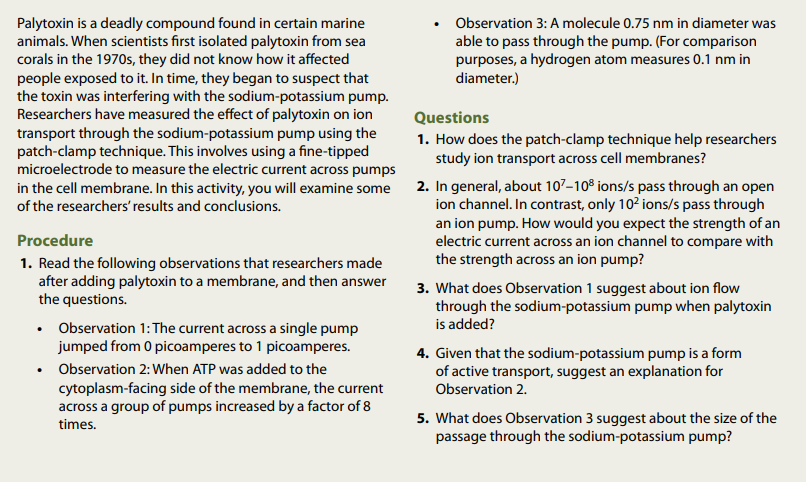500 -potassium pump palytox is added? 4. Given that the sodium-potassium pump is a form of active transport, suggest an explanation for Observation 2. 5. What does Observation 3 suggest about the size of the passage through the sodium-potassium pump?
500 -potassium pump palytox is added? 4. Given that the sodium-potassium pump is a form of active transport, suggest an explanation for Observation 2. 5. What does Observation 3 suggest about the size of the passage through the sodium-potassium pump?
Human Anatomy & Physiology (11th Edition)
11th Edition
ISBN:9780134580999
Author:Elaine N. Marieb, Katja N. Hoehn
Publisher:Elaine N. Marieb, Katja N. Hoehn
Chapter1: The Human Body: An Orientation
Section: Chapter Questions
Problem 1RQ: The correct sequence of levels forming the structural hierarchy is A. (a) organ, organ system,...
Related questions
Question
4 and 5 please

Transcribed Image Text:Palytoxin is a deadly compound found in certain marine
animals. When scientists first isolated palytoxin from sea
corals in the 1970s, they did not know how it affected
people exposed to it. In time, they began to suspect that
the toxin was interfering with the sodium-potassium pump.
Researchers have measured the effect of palytoxin on ion
transport through the sodium-potassium pump using the
patch-clamp technique. This involves using a fine-tipped
microelectrode to measure the electric current across pumps
in the cell membrane. In this activity, you will examine some
of the researchers' results and conclusions.
Procedure
1. Read the following observations that researchers made
after adding palytoxin to a membrane, and then answer
the questions.
• Observation 1: The current across a single pump
jumped from 0 picoamperes to 1 picoamperes.
• Observation 2: When ATP was added to the
cytoplasm-facing side of the membrane, the current
across a group of pumps increased by a factor of 8
times.
Observation 3: A molecule 0.75 nm in diameter was
able to pass through the pump. (For comparison
purposes, a hydrogen atom measures 0.1 nm in
diameter.)
Questions
1. How does the patch-clamp technique help researchers
study ion transport across cell membranes?
2. In general, about 107-108 ions/s pass through an open
ion channel. In contrast, only 10² ions/s pass through
an ion pump. How would you expect the strength of an
electric current across an ion channel to compare with
the strength across an ion pump?
3. What does Observation 1 suggest about ion flow
through the sodium-potassium pump when palytoxin
is added?
4. Given that the sodium-potassium pump is a form
of active transport, suggest an explanation for
Observation 2.
5. What does Observation 3 suggest about the size of the
passage through the sodium-potassium pump?
Expert Solution
This question has been solved!
Explore an expertly crafted, step-by-step solution for a thorough understanding of key concepts.
Step by step
Solved in 3 steps

Knowledge Booster
Learn more about
Need a deep-dive on the concept behind this application? Look no further. Learn more about this topic, biology and related others by exploring similar questions and additional content below.Recommended textbooks for you

Human Anatomy & Physiology (11th Edition)
Biology
ISBN:
9780134580999
Author:
Elaine N. Marieb, Katja N. Hoehn
Publisher:
PEARSON

Biology 2e
Biology
ISBN:
9781947172517
Author:
Matthew Douglas, Jung Choi, Mary Ann Clark
Publisher:
OpenStax

Anatomy & Physiology
Biology
ISBN:
9781259398629
Author:
McKinley, Michael P., O'loughlin, Valerie Dean, Bidle, Theresa Stouter
Publisher:
Mcgraw Hill Education,

Human Anatomy & Physiology (11th Edition)
Biology
ISBN:
9780134580999
Author:
Elaine N. Marieb, Katja N. Hoehn
Publisher:
PEARSON

Biology 2e
Biology
ISBN:
9781947172517
Author:
Matthew Douglas, Jung Choi, Mary Ann Clark
Publisher:
OpenStax

Anatomy & Physiology
Biology
ISBN:
9781259398629
Author:
McKinley, Michael P., O'loughlin, Valerie Dean, Bidle, Theresa Stouter
Publisher:
Mcgraw Hill Education,

Molecular Biology of the Cell (Sixth Edition)
Biology
ISBN:
9780815344322
Author:
Bruce Alberts, Alexander D. Johnson, Julian Lewis, David Morgan, Martin Raff, Keith Roberts, Peter Walter
Publisher:
W. W. Norton & Company

Laboratory Manual For Human Anatomy & Physiology
Biology
ISBN:
9781260159363
Author:
Martin, Terry R., Prentice-craver, Cynthia
Publisher:
McGraw-Hill Publishing Co.

Inquiry Into Life (16th Edition)
Biology
ISBN:
9781260231700
Author:
Sylvia S. Mader, Michael Windelspecht
Publisher:
McGraw Hill Education